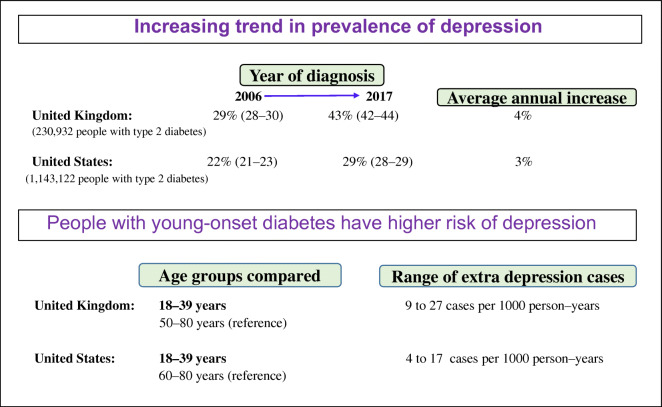- Record: found
- Abstract: found
- Article: found
Temporal trends in the prevalence and incidence of depression and the interplay of comorbidities in patients with young- and usual-onset type 2 diabetes from the USA and the UK

Read this article at
Abstract
Aims/hypothesis
We aimed to investigate the prevalence and incidence of depression, and the interplay of cardiometabolic comorbidities, in the differentiation of depression risk between young-onset diabetes (diagnosis at age <40 years) and usual-onset diabetes (diagnosis at age ≥40 years).
Methods
Using electronic medical records from the UK and USA, retrospective cohorts of adults with incident type 2 diabetes diagnosed between 2006 and 2017 were examined. Trends in the prevalence and incidence of depression, and risk of developing depression, in participants with young-onset type 2 diabetes compared with usual-onset type 2 diabetes were assessed separately by sex and comorbidity status.
Results
In total 230,932/1,143,122 people with type 2 diabetes from the UK/USA (mean age 58/60 years, proportion of men 57%/46%) were examined. The prevalence of depression in the UK/USA increased from 29% (95% CI 28, 30)/22% (95% CI 21, 23) in 2006 to 43% (95% CI 42, 44)/29% (95% CI 28, 29) in 2017, with the prevalence being similar across all age groups. A similar increasing trend was observed for incidence rates. In the UK, compared with people aged ≥50 years with or without comorbidity, 18–39-year-old men and women had 23–57% and 20–55% significantly higher risks of depression, respectively. In the USA, compared with those aged ≥60 years with or without comorbidity, 18–39-year-old men and women had 5–17% and 8–37% significantly higher risks of depression, respectively.
Conclusions/interpretation
Depression risk has been increasing in people with incident type 2 diabetes in the UK and USA, particularly among those with young-onset type 2 diabetes, irrespective of other comorbidities. This suggests that proactive mental health assessment from the time of type 2 diabetes diagnosis in primary care is essential for effective clinical management of people with type 2 diabetes.
Related collections
Most cited references33
- Record: found
- Abstract: not found
- Article: not found
Type 2 diabetes in adolescents and young adults
- Record: found
- Abstract: found
- Article: not found
Generalisability of The Health Improvement Network (THIN) database: demographics, chronic disease prevalence and mortality rates.
- Record: found
- Abstract: not found
- Article: not found
